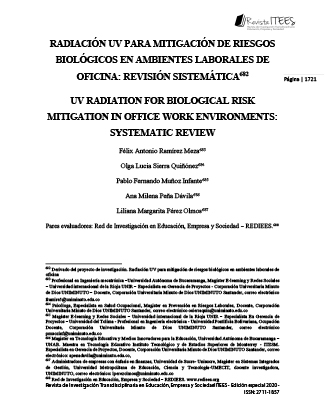XC. UV RADIATION FOR BIOLOGICAL RISK MITIGATION IN OFFICE WORK ENVIRONMENTS: SYSTEMATIC REVIEW
##plugins.themes.bootstrap3.article.main##
Abstract
Ultraviolet (UV) light was discovered by Johann Ritter in 1801 and it took more than a
hundred years to develop equipment that would allow its application at industrial scales; One
of the spectra, Ultraviolet C radiation (UVC) is used in water sterilization, food disinfection,
asepsis of clinical environments, disinfection of air conditioning systems and surfaces,
among other applications. The objective of this work is to describe the use of UVC radiation
for the mitigation of biological risks in office work environments. An analysis of information
on experimental studies was carried out where the germicidal and disinfecting effect of UVC
radiation was verified by laboratory tests. The technique used in this article has been
documentary research through databases such as SCOPUS, SCIENCE DIRECT,
REDALYC, SCIELO in periods between 2000 and 2018, most of them in English. The
experimental results in different applications confirm that the germicidal effect of UVC
radiation is an effective tool to inactivate and eliminate polluting agents that are harmful and
that can occur in work environments. Therefore, UVC radiation could work and be effective
for the reduction of biological risks in office environments, which in some cases cause
diseases and lead to work absences. In this way, the article becomes the starting point for
experimental research on the effect of UVC radiation on the health conditions of a working
population.
Download Statistics
##plugins.themes.bootstrap3.article.details##
ultraviolet radiation, ultraviolet disinfection, UVC radiation, occupational health, work environments





